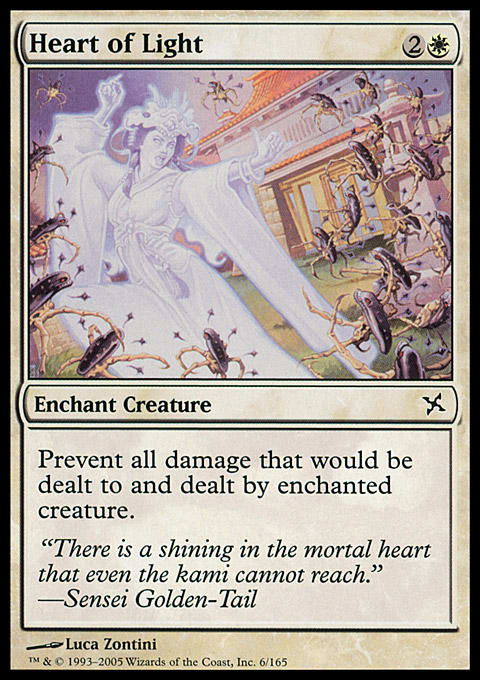I believe in the power of Magic to enrich lives.
I’ve seen it in the lives of people around me. I’ve seen it in my life. I’ve been playing for seven years, and in that time, I’ve learned a very important lesson: The busier and more stressful my life becomes, the more important it is to stay connected to the things that keep me centered. This includes reading, writing, spending time with people who are important to me—and of course, Magic.
I’ve never quite been able to articulate why this is so important, but I know instinctively that it is. Right now, I’m managing to balance my school and work obligations with Friday Night Magic, occasional judging, keeping active in the online community, and transcribing Mark Rosewater’s podcast. During the busiest times, I’ve gone down to just prereleases. But even then, I’ve managed to keep current through the Internet and talking with my friends. I’ve found from experience that I’m just happier when I’m tied into the game and the community throughout my weekly routine.
The Magic Club
In fact, I believe in the life-enriching properties of Magic so strongly that I actually put it into action at work. For those who don’t know, I am in a clinical psychology graduate school program. As part of our program, I do hands-on training at a few different training sites: I’ve worked in a school, I’ve worked in a developmental assessment clinic, and I’m currently doing my final internship with a psychologist’s office in Wyoming.
A couple of years ago, I worked in a facility for people with severe mental illnesses like schizophrenia. It was a residential facility, meaning people lived there full-time, and it was locked. The people who lived there were in there all day, almost every day, typically for months or even years.
My supervisor, wanting to find ways to make the residents’ time there more meaningful, asked the students to start doing different weekly programs with them. He encouraged us to bring in something that was important in our own lives. One person did a cooking class, and one did an acting class. I think you can guess what I did.
Each week, the Magic group met up. There was almost always someone new, so I spent a lot of the time teaching people how to play with help from the more experienced residents. The group was incredibly popular and received special praise from the facility’s Program Director. It seemed to get people engaged not only with the weekly group, but with other aspects of the facility as well. Many people in the group started hanging out in between weekly meetings to play. Some of them started going to more of the other groups the facility offered, such as “Health and Diet” or “Anger Management.”
Now, my background is in behaviorism, so that was an important part of the program—you reinforce (i.e. reward, approximately) actions that you want to see more of. People earned cards each week, and the more you followed facility rules and participated in groups, the more you could earn. On some level, it was a simple behavior program.
Only it didn’t seem to be so simple. The group was attached to an existing behavior program—people already earned snacks and privileges for doing these things. Now, I’m sure you can imagine that new Magic cards are pretty motivating, but I do think there was more to it. I believe that many of the residents loved Magic for the same reasons that we do—it just makes our lives better.
Positive Psychology
Many people have spent a lot of time trying to explain what Magic does for us. They often focus on concrete skills such as math, vocabulary, and critical thinking. Others look at the social benefits, in terms of new people met and time spent with friends. I’ve tackled this again and again from many different angles: the many different benefits of the community, the impact of play, and good role models. One lens that can be particularly valuable for understanding this is that of positive psychology.
Positive psychology was founded on the premise that psychology focuses too often on just patching up what is wrong. In contrast, its practitioners focus on bolstering the positive aspects of life. This includes finding life-enriching experiences, identifying and using personal strengths, and encouraging positive interactions with the community (Seligman & Csikszentmihalyi 5).
Many of these have been found to help protect against mental illness (Seligman & Csikszentmihalyi 2000 ). There is evidence that positive psychotherapy, which emphasizes building positive experiences such as gratitude and optimism, can be effective in reducing depression and improve well-being (Rashid 204-205).
One key idea of positive psychology is the way it quantifies happiness. While dysfunction can easily be measured in terms of symptoms and impairment, happiness is a bit slipperier. One person may find happiness through being successful at a job he or she loves while another may insist that work is secondary and happiness is all about spending time with loved ones.
In an effort to capture these experiences in a way that can be studied scientifically, positive psychology researchers broke the common conceptions of happiness into its different components. In the end, they came up with the three routes to happiness (Seligman, Parks & Steen 1380).
These routes go by many names. Some people call them the three orientations (Peterson, Park, & Seligman 25), and some call them the three lives (Rashid 195). All of these are a bit misleading, as they make the three sound mutually exclusive. In reality, while each contributes to happiness in its own way (Peterson, Park, & Seligman 36), one person can pursue all three.
The Big Three
The first of these is sometimes called “the pleasurable life” (Seligman, Parks & Steen 1380). This involves simple positive emotion—for example, pleasure and hope. Taking this route to happiness involves finding what is enjoyable about life and really making the most of it (Seligman, Parks & Steen, 1380). Some research emphasizes seeking out frequent pleasurable experiences, such as good food or a chance to relax (Rashid 196), while others focus on increasing awareness by cultivating mindsets such as mindfulness and gratitude (Seligman, Parks & Steen, 1380).
The second route is that of engagement. This involves seeking out deep absorption in which everything else falls away. While the absorbing activity may not be pleasurable in the traditional sense, as in the case of a marathon, on reflection, it is found to be deeply gratifying. These activities call on the use of our strengths (Seligman, Parks & Steen, 1380), leading some to see engagement as an authentic expression of ourselves (Rashid 197).
The third route to happiness is sometimes called “the meaningful life” (Seligman, Parks & Steen, 1380). While engagement involves using our strengths for our own reward, the meaningful life is using our strengths for something deeper. Possible motivations include spirituality, the community, or ideals, such as knowledge or justice. It is a sense of having a purpose, of being connected to something larger than yourself (Seligman, Parks & Steen, 1380).
Next Week . . .
I will be talking specifically about how these three routes relate to Magic. I have found the game and the community to offer meaningful entry into all three. It has been said that Magic isn’t just a game, it’s a lifestyle. I believe that part of what makes that so rewarding—for me, for the people around me, for the residents in my group at the facility—is that it not only offers opportunities to follow these three routes to happiness, it actively encourages it.
Different people tend to focus on different routes to happiness, (Peterson, Park, & Seligman 36), and we all find our unique and individually relevant ways of pursuing them. Take some time to think about how these three routes can and do apply to your own life, and we’ll talk in-depth next week.
Works Cited
- Peterson, Christopher, Nansook Park, and Martin E.P. Seligman. "Orientations to Happiness and Life Satisfaction: The Full Life vs. The Empty Life."Journal of Happiness Studies. 6. (2005): 25-41. Web. 6 Oct. 2013.
- Rashid, Tayyab. "Positive Psychotherapy." Positive Psychology: Exploring the Best in People. Westport, CT: Praeger, 2008. Web.
- Seligman, Martin E.P., Acacia C. Parks, and Tracy Steen. "A Balanced Psychology and a Full Life."Philosophical Transactions of the Royal Society. 359. (2004): 1379-1381. Web. 6 Oct. 2013.
- Seligman, Martin E.P., and Mihaly Csikszentmihalyi. "Positive Psychology: An Introduction." American Psychologist. 55.1 (2000): 5-14. Web. 6 Oct. 2013.




























